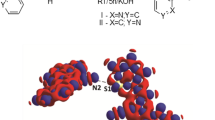Abstract
The protonation constants, log K, for 1,4,7,11-tetraazacyclotetradecane (isocyclam, 2), 1-(2-aminoethyl)-1,4,8,11-tetraazacyclotetradecane (scorpiand, 3), 5,12-dimethyl-1,4,8,11-tetraazacyclotetradecane (Me2cyclam, 4) and 5,5,7,12,14,14-hexamethyl-1,4,8,11- tetraazacyclotetradecane (Me6cyclam, 5) were determined pH-metrically. Attempts of correlation of the calculated enthalpy of protonation in the gas phase (AM1 method) with experimental values of the protonation constants for ligands 1, 2, 4–7 were done 1,4,8,11-tetraazacyclotetradecane, cyclam, 1; 1,4,7,10-tetraazacyclotetradecane, cyclen, 6; 1,4,8,11-tetramethyl-1,4,8,11-tetraazacyclotetradecane, (N-Me)4cyclam, 7. Extensive NMR pH-titrations, i.e., determination of pH vs. chemical shifts (1H and/or 13C) plots, (δX = f(pH), allowed to suggest the most likely protonation schemes of all nitrogen atoms in the cyclic polyamines 1–3. The possibility of the formation-breaking of the intramolecular hydrogen bonds, as well as the change of conformation of these polybasic macrocycles during protonation-deprotonation steps, has been considered on the basis of the supplementary theoretical calculations (MMX/STO-3G study).
Similar content being viewed by others
References
For Parts 1 and 2, see refs. 26 and 27, respectively.
R. Bhula, P. Osvath, and D. C. Weatherburn: Coord. Chem. Rev. 91, 89 (1988).
P. V. Bernhardt and G. A. Lawrance: Coord. Chem. Rev. 104, 297 (1990).
A. E. Martell and R. D. Hancock: Metal Complexes in Aqueous Solutions, Plenum Press, New York (1996).
K. B. Yatsimirskii: Zh. Neorg. Khim. 36, 2010 (1991).
L. Sabatini and L. Fabbrizzi: Inorg. Chem. 18, 438 (1979).
P. S. Pallavicini, A. Perotti, A. Poggi, B. Seghi, and L. Fabbrizzi: J. Am. Chem. Soc. 109, 5139 (1987).
R. J. Motekaitis and A. E. Martell: Can. J. Chem. 60, 168 (1982).
A. Izquierdo and J. L. Beltran: Anal. Chim. Acta 181, 87 (1986).
HyperChem® for Windows, Release 4.5, Publication HC45-00-01-00, May 1995, Hypercube, Inc., Waterloo, Ontario, Canada N2L 3X2.
J. J. P. Stewart: J. Computer-Aided Mol. Design 4, 1 (1990).
PCMODEL, Molecular Modeling Software for the IBM PC/XT/AT and Compatibles, Serena Software, Bloomington, IN 47402-3076, USA.
M. Saunders: J. Am. Chem. Soc. 109, 3150 (1987).
A. K. Covington, M. Paabo, R. A. Robinson, and R. G. Bates: Anal. Chem. 40, 700 (1968), and references therein.
J. Costa and R. Delgado: Inorg. Chem. 32, 5257 (1993), and refs. therein.
A. Bianchi, B. Escuder, E. García-Espana, S. V. Luis, V. Marcelino, J. F. Miravet, and J. A. Ramírez: J. Chem. Soc., Perkin Trans. 2 1253 (1994).
A. Grzejdziak: Monatsh. Chem. 125, 107 (1994).
A. P. Leugger, L. Hertli, and T. A. Kaden: Helv. Chim. Acta 61, 2296 (1978).
R. B. Nazarski, D. Sroczyński, P. Urbaniak, J. Dziegieć, and A. Grzejdziak: 36th IUPAC Congress, Geneva, August 17–22, 1997, poster SB-I16; Chimia 51, 432 (1997).
M. Kodama and E. Kimura: J. Chem. Soc., Dalton Trans. 327 (1980).
The detailed structural studies, especially concerning the NMR resonance assignments for the complex scorpiand systems, will be published soon.
In certain pH intervals signal assignments for objects 2 and 3 are tentative due to crossover of the titration curves, which does not influence the proposed protonation schemes.
R. B. Nazarski and D. Sroczyński: Symposium on Application of Magnetic Resonance in Chemistry and Related Areas, Warsaw, June 24–26, 1998, poster P32.
M. Micheloni, P. Paoletti, and A. Vacca: J. Chem. Soc., Perkin Trans. 2 945 (1978).
H.-O. Kalinowski, S. Berger, and S. Braun: Carbon-13 NMR Spectroscopy, John Wiley, Chichester, 1988, pp. 222–226.
M. Cygler, K. Dobrynin, M. J. Grabowski, R. B. Nazarski, and R. Skowroński: J. Chem. Soc., Perkin Trans. 2 1495 (1985).
R. B. Nazarski and R. Skowroński: J. Chem. Soc., Perkin Trans. 1 1603 (1989).
Author information
Authors and Affiliations
Rights and permissions
About this article
Cite this article
Nazarski, R.B. Physical Image vs. Structure Relation. Part 3 [1]. Basic Properties and Protonation Mechanism of Some Tetraaza Macrocyclic Ligands. Journal of Inclusion Phenomena 35, 251–260 (1999). https://doi.org/10.1023/A:1008199016005
Issue Date:
DOI: https://doi.org/10.1023/A:1008199016005




